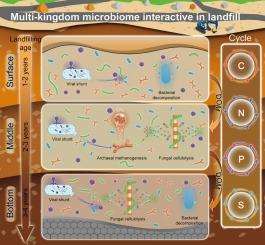多领域微生物群相互作用的时空动态驱动垃圾填埋场CNPS循环
IF 7.1
2区 环境科学与生态学
Q1 ENGINEERING, ENVIRONMENTAL
引用次数: 0
摘要
垃圾填埋场生态系统是重要的陆地碳汇,城市生活垃圾通过多界微生物群介导的生化反应进行分解转化。然而,在这些多界微生物组中,微生物相互作用和协作的时空特征在很大程度上仍然未知。在这项研究中,我们揭示了多领域微生物群驱动碳、氮、磷和硫在30米填埋深度(对应于1至4年的填埋年龄)内循环的分层和协作机制。通过整合宏基因组学和网络分析,我们阐明了微生物群落结构和功能的垂直演替模式。表层(1-2年)主要以细菌为主的初级代谢为主,推断水生肠球菌(Enterococcus aquimarinus)和bullatbrevundimonas bullata通过发酵、固氮和溶磷介导代谢耦合。同时,噬菌体驱动的宿主裂解可能有助于抑制酸化。在中间层(2-3年),古生菌和真菌的共生模式表明,真菌(如粗壮厌氧菌)可以为产甲烷菌(如乙醇甲烷菌)提供关键的底物。在底层(3-4年),真菌、细菌和病毒在营养有限的条件下合作,噬菌体采用“杀死赢家”的方法来维持生态系统的功能和稳定。总的来说,我们的研究结果表明,跨界的关键微生物连接器通过跨界相互作用促进元素循环,包括底物交换和营养供应。该研究促进了我们对生活垃圾分解过程中多界微生物动力学的理解,并为提高垃圾填埋场生态系统内生物地球化学循环效率提供了一个概念框架。本文章由计算机程序翻译,如有差异,请以英文原文为准。

Spatiotemporal dynamics of multi-kingdom microbiome interactions drive CNPS cycling in landfills
Landfill ecosystems represent significant terrestrial carbon sinks, where municipal solid waste (MSW) undergoes decomposition and transformation through biochemical reactions mediated by multi-kingdom microbiome. However, the spatial and temporal characterization of microbial interactions and collaboration within these multi-kingdom microbiomes remain largely unknown. In this study, we reveal the hierarchical and collaborative mechanisms by which multi-kingdom microbiomes drive carbon, nitrogen, phosphorus, and sulfur cycling across a 30-meter landfilling depth, corresponding to a landfilling age of 1 to 4 years. Through integration of metagenomics and network analyses, we elucidated vertical succession patterns in microbial community structure and function. The surface layer (1–2 years) was centered on bacterial-dominated primary metabolism, with Enterococcus aquimarinus and Brevundimonas bullata inferred to mediate metabolic coupling through fermentation, nitrogen fixation andphosphorus solubilization. Concurrently, phage-driven host lysis may contribute to the suppression of acidification. In the middle layer (2–3 years), co-occurrence patterns between archaea and fungi suggest mutualistic interaction supporting methanogenesis, wherein fungi such as Anaeromyces robustus would supply key substrates for methanogens such as Methanofollis ethanolicus. In the bottom layer (3–4 years), fungi, bacteria, and viruses collaborate under nutrient-limited conditions, with phages employing a “kill-the-winner” approach to sustain ecosystem function and stability. Collectively, our findings indicate that key microbial connectors across kingdoms contribute to elemental cycling through cross-kingdom interaction, including substrate exchange and nutrient supply. This study advances our understanding of multi-kingdom microbial dynamics during MSW decomposition and offers a conceptual framework for enhancing biogeochemical cycling efficiency within landfill ecosystems.
求助全文
通过发布文献求助,成功后即可免费获取论文全文。
去求助
来源期刊

Waste management
环境科学-工程:环境
CiteScore
15.60
自引率
6.20%
发文量
492
审稿时长
39 days
期刊介绍:
Waste Management is devoted to the presentation and discussion of information on solid wastes,it covers the entire lifecycle of solid. wastes.
Scope:
Addresses solid wastes in both industrialized and economically developing countries
Covers various types of solid wastes, including:
Municipal (e.g., residential, institutional, commercial, light industrial)
Agricultural
Special (e.g., C and D, healthcare, household hazardous wastes, sewage sludge)
 求助内容:
求助内容: 应助结果提醒方式:
应助结果提醒方式:


